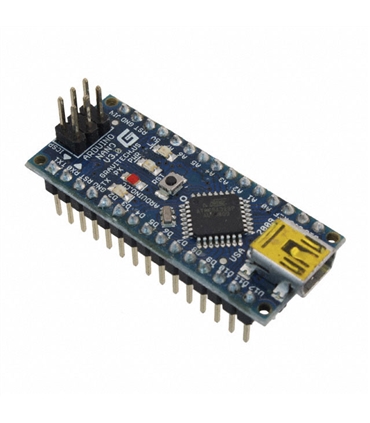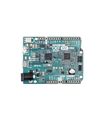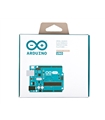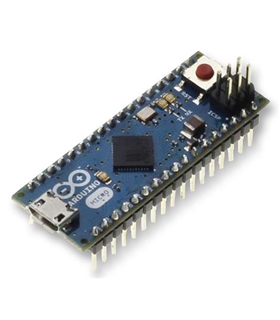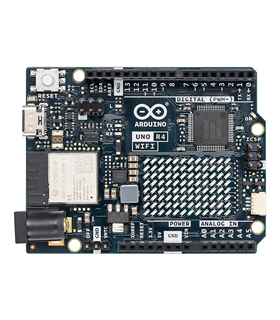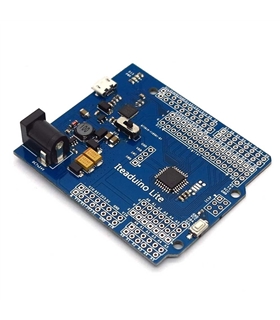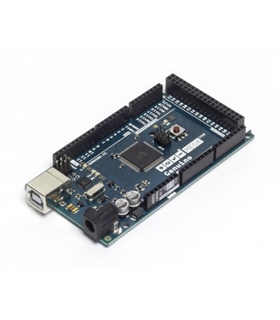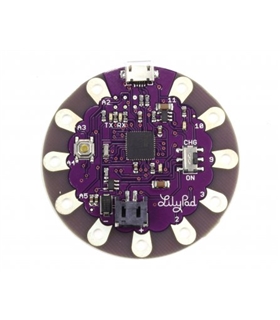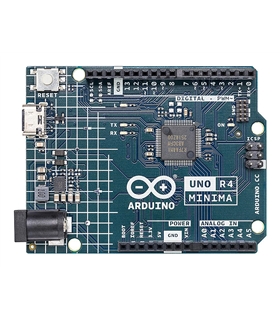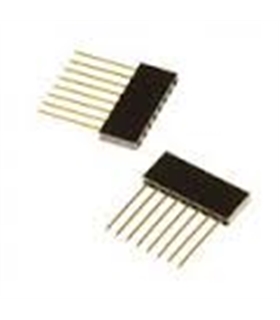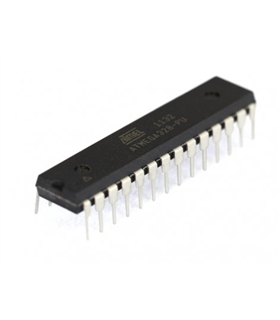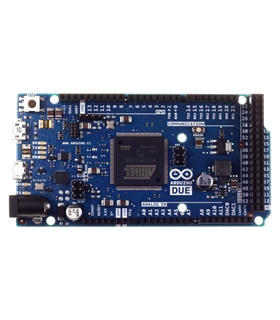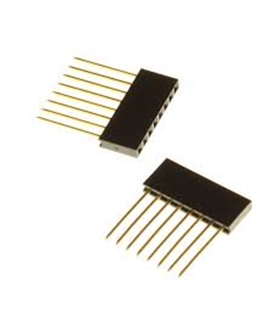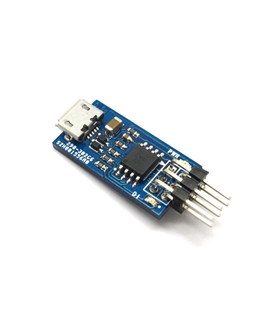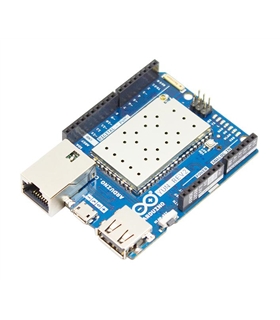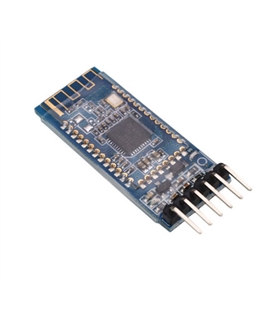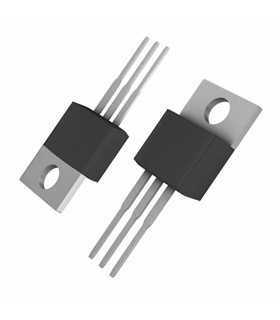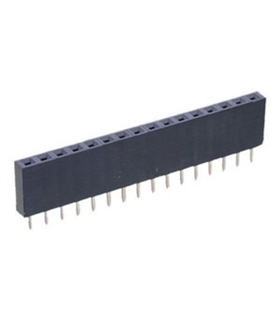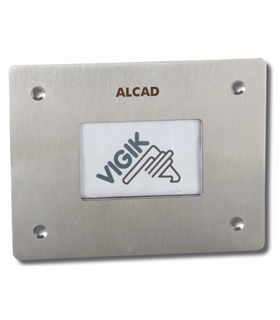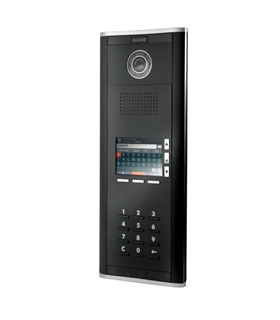Description: The Arduino Nano is a small, complete, and breadboard-friendly board based on the ATmega328 (Arduino Nano 3.0). It has more or less the same functionality of the Arduino Duemilanove, but in a different package. It lacks only a DC power jack, and works with a Mini-B USB cable instead of a standard one. The Nano was designed and is being produced by Gravitech
The Nano deliver all the features you expect from a Duemilanove or UNO board, it uses the Atmega328, so any code that runs on the UNO will also run on the Nano. Even better, it is breadboard friendly, you can mount it in any breadboard and create working prototype in minutes.
Features:
ATmega328 microcontroller
Operating Voltage / Logic Level: 5V
Input Voltage (recommended): 7-12V
Input Voltage (limits): 6-20V
Digital I/O Pins: 14 (of which 6 provide PWM output)
Analog Input pins: 8
DC Current per I/O Pin: 40 mA
Flash Memory 32 KB (of which 2 KB used by bootloader)
SRAM: 2 KB
EEPROM: 1 KB
Clock Speed 16 MHz
Dimensions: 0.73" x 1.70"
Programming
The Arduino Nano can be programmed with the Arduino software (download). Select "Arduino Duemilanove or Nano w/ ATmega328" from the Tools > Board menu before uploading the source code. The Nano uses the FTDI chip for USB communication, install the correct drivers if your system does not recognize the Nano. The latest version of the drivers can be found on the FTDI website. Also check the Arduino Howto for more details on drivers, and basic setup.
Power
The Arduino Nano can be powered via the Mini-B USB connection, 6-12V unregulated external power supply (pin 30), or 5V regulated external power supply (pin 27), however don't connect more the 5V in pin 27, doing so will permanently kill the Nano. The power source is automatically selected to the highest voltage source, however, the FTDI FT232RL chip on the Nano is only powered if the board is being powered over USB. As a result, when running on external (non-USB) power, the 3.3V output (which is supplied by the FTDI chip) is not available and the RX and TX LEDs will flicker if digital pins 0 or 1 are high.
Input and Output
Each of the 14 digital pins on the Nano can be used as an input or output, using pinMode(), digitalWrite(), and digitalRead() functions. They operate at 5 volts. Each pin can provide or receive a maximum of 40 mA and has an internal pull-up resistor (disconnected by default) of 20-50 kOhms. In addition, some pins have specialized functions:
Serial: 0 (RX) and 1 (TX). Used to receive (RX) and transmit (TX) TTL serial data. These pins are connected to the corresponding pins of the FTDI USB-to-TTL Serial chip.
External Interrupts: 2 and 3. These pins can be configured to trigger an interrupt on a low value, a rising or falling edge, or a change in value. See the attachInterrupt() function for details.
PWM: 3, 5, 6, 9, 10, 11, and 13. Provide 8-bit PWM output with the analogWrite() function.
SPI: 10 (SS), 11 (MOSI), 12 (MISO), 13 (SCK). These pins support SPI communication using the SPI library. They are also available on the ICSP connector.
I2C: A4 (SDA) and A5 (SCL). Support I2C (TWI) communication using the Wire library (documentation on the Wiring website).
Analog Inputs: A0 to A8 The Nano has 8 analog inputs, labeled A0 through A8, all of which can also be used as digital I/O. Pins A4 and A5 can be used for I2C also. Each analog input provide 10 bits of resolution (i.e. 1024 different values) from ground to 5 volts
Communication
An FTDI FT232RL on the board channels this serial communication over USB and the FTDI drivers (included with the Arduino software) provide a virtual com port to software on the computer. The RX and TX LEDs on the board will flash when data is being transmitted via the FTDI chip and USB connection to the computer (but not for serial communication on pins 0 and 1). A SoftwareSerial library allows for serial communication on any of the Nano's digital pins.
Automatic (Software) Reset
The Nano is designed in a way that allows it to be reset by software running on a connected computer using the hardware flow control lines (DTR) of the FT232RL. The Arduino software uses this capability to allow you to upload code by simply pressing the upload button in the Arduino environment. This setup has other implications. When the Nano is connected to either a computer running Mac OS X or Linux, it resets each time a connection is made to it from software (via USB). For the following half-second or so, the bootloader is running on the Nano, and it will intercept the first few bytes of data sent to the board after a connection is opened. Make sure your code has a short delay before sending data to the Nano.
Description: The Arduino Nano is a small, complete, and breadboard-friendly board based on the ATmega328 (Arduino Nano 3.0). It has more or less the same functionality of the Arduino Duemilanove, but in a different package. It lacks only a DC power jack, and works with a Mini-B USB cable instead of a standard one. The Nano was designed and is being produced by Gravitech
The Nano deliver all the features you expect from a Duemilanove or UNO board, it uses the Atmega328, so any code that runs on the UNO will also run on the Nano. Even better, it is breadboard friendly, you can mount it in any breadboard and create working prototype in minutes.
Features:
ATmega328 microcontroller
Operating Voltage / Logic Level: 5V
Input Voltage (recommended): 7-12V
Input Volt ...
36,90 €
Com IVA
Referência:
A000005
Favorito0
Adicionar à lista de desejos
Clique para mais produtos.
Não foram encontrados produtos.
-
-
-
- Semicondutores
- Audio & Tv
- Resistências
- Condensadores
- Fusíveis
- Optoelectronica & Sensores
- Interruptores
- Relés
- Fichas
- Cristais
- Leds
- Potenciómetros
- Varistores
- Bobines & Choques
- Disjuntores
- Microfones
- Bezouros
- Potenciómetros Trimmers
-
-
-
502,76 € Com IVAPainel Anti-Vandalo RFIDAlcad: LPR-000 ; 9690011Mais Info em:http://www.alcad.net/uploads/hojas/2636750.01.pdf1 377,60 € Com IVAPlaca de rua iBLACK com grupo fónico 2 fios, telecamara genérica cores, ecran TFT, directorio electrónico e teclado. Para porta edificio Alcad: PDK-51910 ; 9800116
-
-
-
-
-
-
-
-
-
-
-
- Geradores de Funções & Frequencimetros
- Pinças Amperimetricas
- Termometros & Higrómetros
- Luximetros
- Testadores de Redes
- Comprovadores de Tensão
- Medidores de Distancias
- Outros
- Capacimetros & LCR
- Amperimetros & Voltimetros
- Taquimetros
- Multimetros
- Osciloscopios
- Acessórios
- Medidores de Terra & Isolamento
- Analisadores de Espectro
- Níveis Laser
- MultimetrosTesto
-
-
-

